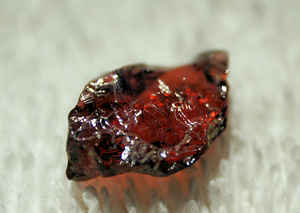New York State Gem
Garnet

Adopted in 1969
The garnet was adopted as the State gem in 1969. The dark red garnet is an eye-appealing gem as well as a prized industrial abrasive. Barton Mines in the Adirondack Mountains is the world's largest garnet mine. Garnets are used in jewelry and are a dark red color. Most garnet is used as an industrial abrasive, but occasionally gem quality stones are found. Garnet's hard, sharp features make it excellent for grinding lenses and for polishing glass and metal.
Garnet: New York State Gem

The name garnet comes from the Latin word for pomegranate, malum granatum, due to the resemblance of some varieties of garnet to red pomegranate seeds. Their use as gems has a history that goes back to the ancient Egyptians.
The word "garnet" is believed to have come from the Greek word "granatum," or pomegranate seed, because ancient jewelry makers grouped the tiny gemstones in a cluster that resembled the seed-filled fruit. Deep red in color, almandine garnet is the most popular gem in the garnet family. Occasionally deep enough red to appear black, almandine garnet is sometimes hollowed in order to let light shine through the stone, highlighting its red color. Garnet displays the greatest variety of color of any mineral, occurring in every color except blue.
Garnet is not a single mineral, but a group contains closely related, isomorphous minerals that form a series with each other. The Garnet members
form intermediary minerals between each member, and may even intergrow within a single crystal. The Garnets vary only slightly in physical properties,
and some of the members may be so similar that they are indistinguishable from one another without x-ray analysis.
The common Garnets can be divided into two subgroups:
Group 1: Garnets containing aluminum (Al) as their second element. These include Pyrope, Almandine, and Spessartine. ("Pyralspite")
Group 2: Garnets containing calcium (Ca) as their first element. These include Uvarovite, Grossular, and Andradite. ("Ugrandite")
Since 2003 New York State has ranked first in industrial garnet-production in the United States. Since there are just a few companies that account for all U.S. industrial garnet production, USGS does not publish detailed production statistics for New York State. However, generally speaking, Barton Mines in Warren County is the largest U.S. garnet producer. NYCO Minerals probably ranks third in the country; the company produces accessory garnet with their main product, wollastonite.
Barton currently extracts garnet from its Ruby Mountain mine in the Town of Johnsburg. However the company's nearby Gore Mountain mine, which opened in 1878 and ran until 1983, was the largest garnet mine in the world during its operation. Garnets from the company's current Ruby Mountain site make especially high-quality abrasives. Most New York garnet is used for sandpaper. Garnet is also used in grinding and polishing glass and metal, sandblasting, water filtration and waterjet stone cutting. Garnet is a well-known gemstone, but most New York garnets have too many internal imperfections to be used in jewelry.
JANUARY Birthstone

Garnet is the birthstone for January, and is also the accepted anniversary gemstone for the 2nd year of marriage. The gemstone's resemblance to pomegranate seeds earned its name, from the Latin word for the crimson fruit, granatum. Its deep red color symbolizes passionate devotion, friendship, vitality, and balance. Garnet, derived from the word granatum, means seed, and is called so because of the gemstone's resemblance to a pomegranate seed. The gemstone dates back to 3100 BC, when the Egyptians used garnets as inlays jewelry. Legend holds that Noah hung a large garnet in the ark for illumination. It reportedly also gives its wearer guidance in the night, protection from nightmares, and according to Egyptians, is an antidote for snakebites and food poisoning. Garnets are durable and brilliant and the most popular color of a garnet is reddish-brown, it comes in other colors such as purple, pink, violet, green, yellow, orange, red, brown, black, and even colorless.
New York Laws
The law designating the garnet as the official New York state gem is found in the New York State Consolidated Laws, STL, Article 6, Section 77.
STATE LAWS
ARTICLE 6 - ARMS AND GREAT SEAL OF STATE.
SECTION 77.
§ 77. State gem. The garnet shall be the official gem of the state of New York.
Physical Properties of Garnet
- Chemical Classification: silicate
- Color: typically red, but can be almost any color with orange, green, yellow and purple being common
- Streak: colorless
- Luster: vitreous
- Diaphaneity: transparent to translucent
- Cleavage: none
- Mohs Hardness: 6.5 to 7.5
- Specific Gravity: 3.5 to 4.3
- Diagnostic Properties: hardness, color, specific gravity, isometric crystal habit
- Chemical Composition: general formula X3Y2(SiO4)3
- Crystal System: isometric
- Uses: waterjet cutting granules, abrasive blasting granules, filtration granules, abrasive grits and powders, gemstones
Minerals, & Gems

Gemstone, Minerals, Rocks







